samedi, 05 février 2022
Le phénomène turkmène
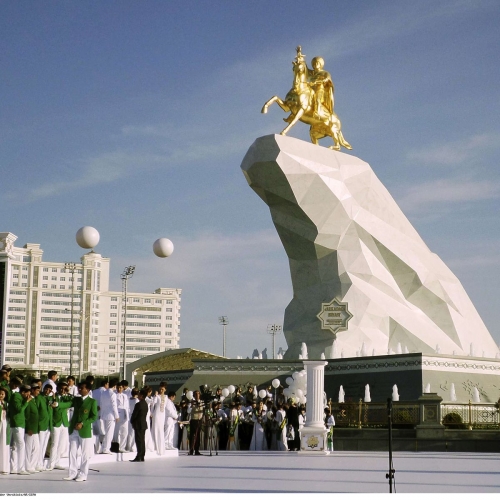
Le phénomène turkmène
Ex: https://katehon.com/ru/article/fenomen-turkmenii
L'une des anciennes républiques soviétiques les plus fermées montre des merveilles de résilience. Cependant, il y a aussi ses faiblesses.
Presque immédiatement après l'effondrement de l'URSS, Achkhabad a proclamé une politique de "neutralité", qui a finalement conduit à un isolement de facto par rapport aux anciens alliés soviétiques. Cette politique est le résultat d'un choix personnel du président Saparmurat Niyazov. Une analyse objective de ce qui se passe dans la république est difficile car de nombreuses données ne sont pas rendues publiques ou sont publiées sous une forme délibérément déformée.
Le Turkménistan a hérité de l'Union soviétique d'importantes ressources souterraines, notamment du gaz naturel, dont les réserves prouvées le placent au quatrième rang mondial. Aux dépens du budget général de l'URSS, les industries d'extraction et de transformation - pétrole et gaz, chimie et construction de machines - ont été construites dans la république dans les années 1990. Saparmurat Niyazov s'était initialement fixé pour objectif de construire une économie qui combinerait des éléments des principes du marché avec la domination de l'État, créant ainsi un système de capitalisme monopolistique d'État aux caractéristiques asiatiques. Comme ses voisins de la région, le Turkménistan a entrepris un certain nombre de réformes après l'effondrement de l'URSS, principalement liées à la formation d'autorités et de structures de gouvernance spécifiques, ainsi que d'institutions économiques de base.

Toutefois, contrairement aux autres pays du P5 d'Asie centrale, les réformes du Turkménistan étaient de nature limitée, voire quasi-marchande, et visaient à adapter le secteur des exportations de l'économie nationale à l'intégration aux marchés extérieurs des matières premières et, en partie, des capitaux. À tous les autres égards, le rôle prédominant de l'État, avec des inclusions de socialisme, devait être maintenu. Dans un premier temps, Achkhabad a été contraint d'entretenir les relations les plus étroites possibles avec Moscou : seule la Russie pouvait garantir la sécurité de la république post-soviétique la plus méridionale. Dans les premières années de l'indépendance, de nombreux officiers russes ont servi dans l'armée du Turkménistan. Pour cette raison, les citoyens russophones du pays ont été autorisés à posséder une double nationalité jusqu'au début des années 2000. Cependant, en termes de priorités de développement, Ashgabat s'est de plus en plus concentré sur la nature fermée de son économie. Dans les années 2000, le Turkménistan a créé un modèle d'économie fusionnée avec l'État, qui est devenu le principal distributeur et contrôleur des ressources matérielles et financières. Une monnaie nationale, le manat, a été mise en circulation, un système bancaire à deux niveaux dominé par des banques d'État a été mis en place et les systèmes budgétaire et fiscal ont été restructurés. Les investissements étrangers et les investissements en capital propre ont été orientés vers la création de grandes entreprises industrielles, parmi lesquelles il faut mentionner la raffinerie de pétrole de la ville de Turkmenbashi, l'aéroport d'Ashgabat, les entreprises de traitement du coton et de production de produits textiles prêts. Mais le cours des réformes du marché a été plutôt lent. On peut dire que les principales réformes se sont développées après 2007, sous le deuxième président, Gurbanguly Berdymukhamedov. En particulier, le marché des valeurs mobilières, y compris le marché des valeurs mobilières d'État, n'a été établi que dans les années 2010.
Le changement de pouvoir a été un événement marquant pour le Turkménistan. Le 21 décembre 2006, Niyazov est décédé d'une crise cardiaque. Les rênes du pouvoir sont passées de manière inattendue à Gurbanguly Berdymukhamedov, 49 ans, qui aurait été choisi par le Turkmenbashi lui-même pour lui succéder. Il avait déjà été vice-premier ministre du Turkménistan pendant cinq ans. La passation de pouvoir s'est déroulée de manière impressionnante. Cependant, aucun miracle ne s'est produit : le nouveau président a globalement poursuivi le cours politique et économique de son prédécesseur et mentor, à savoir "geler" le Turkménistan, en remplaçant le culte de la personnalité de Niyazov par le sien. Et pourtant, pendant un certain temps, il y a eu quelques progrès dans la vie sociale et économique. Les bibliothèques qui avaient été fermées en 2005 par le décret de Saparmurat Niyazov ont été rouvertes, les dix années de scolarité, précédemment réduites d'une année, ont été rétablies, l'Académie des sciences a été relancée et l'institution d'études de troisième cycle et de doctorat dans les universités du pays a été relancée.
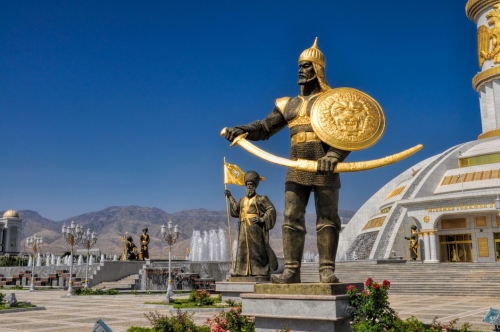
En 2013-2014, les écoles sont passées à un système éducatif de douze ans. Des programmes publics ont été lancés pour soutenir la formation de spécialistes locaux à l'étranger, dans des pays tels que la Malaisie et la Turquie, dans une série de professions requises par le secteur pétrolier et gazier. Ces réformes visaient non seulement à indiquer un vecteur de développement légèrement plus libéral que son prédécesseur, mais aussi à rétablir les qualifications du personnel de direction. Dans l'ensemble, cependant, malgré des réformes structurelles limitées, la production et les exportations de gaz constituent toujours l'épine dorsale de l'économie turkmène sous le nouveau président. Cela entraîne une forte dépendance du budget aux prix mondiaux des produits de base, et aucun mécanisme n'a été créé pour atténuer les effets négatifs des changements défavorables de la situation du marché du commerce extérieur, ce qui a déjà obligé les autorités à commencer à réduire les programmes sociaux depuis le milieu des années 2010. Les seules évolutions positives sont perceptibles dans l'agriculture : le Turkménistan a non seulement réussi à atteindre l'autosuffisance en céréales, dont les cultures se sont développées au détriment du coton, mais il a également commencé à exporter du blé.
La privatisation post-soviétique au Turkménistan a été extrêmement modeste, se limitant au transfert aux mains du secteur privé de petites entreprises, principalement dans les services, le commerce et l'agriculture. Les terres et le sous-sol sont restés propriété de l'État, et il n'existe toujours pas de marché foncier. L'épine dorsale de l'économie turkmène depuis le début du XXIe siècle est constituée de grandes entreprises et banques d'État. La plupart d'entre eux sont des monopolistes dans leur domaine, notamment le complexe pétrolier et gazier, qui représente plus d'un tiers du PIB du Turkménistan. La production de gaz est concentrée au sein de l'entreprise publique Turkmengaz, qui exploite plus de 30 champs, dont Dovletabad, Shatlyk, Malay et Kerpichli. La production de pétrole est assurée par l'entreprise publique Turkmenneft, tandis que l'exploration géologique est assurée par Turkmengeologiya. Aux dépens des revenus pétroliers et gaziers, jusqu'en 2019, la population s'est vu fournir gratuitement, mais dans la limite de quotas établis par l'État, certains services de logement et d'utilité publique, ainsi que certains produits de première nécessité : carburant pour les propriétaires de voitures, sel et pain. Il s'agissait d'une sorte de contrat social sous Saparmurat Niyazov, qui était orienté vers la pratique des "pétrocraties" du Moyen-Orient - Arabie saoudite, Qatar, EAU. À son initiative, une stratégie de développement économique, politique et culturel sur sept ans a été adoptée en 2003 pour le Turkménistan, l'accent étant mis sur l'amélioration du niveau de vie. Il a promis d'augmenter les salaires au rythme impressionnant de 20 à 25 % par an, de multiplier par 5,3 le financement public des programmes sociaux et de préserver la gratuité de l'enseignement et des soins de santé. Cette stratégie avait des taux de croissance économique et industrielle absolument fantastiques, de 22 à 24 % en moyenne par an.
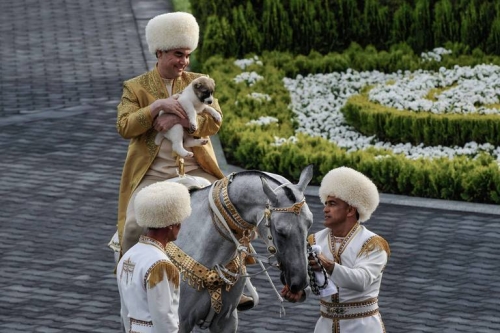
Mais dans la pratique, la plupart des dispositions de ce document n'ont jamais été appliquées, ni en termes de croissance des revenus réels de la population, ni en termes de paramètres quantitatifs du développement économique et industriel. En outre, le Turkménistan est le seul pays post-soviétique dont les performances macroéconomiques ne bénéficient pas de la confiance des experts internationaux. Même le FMI a fini par abandonner l'utilisation des statistiques officielles turkmènes et a basé ses publications sur des estimations générées par la mission du FMI. Les recettes d'exportation n'ont pas été utilisées pour diversifier l'économie. Ils ont surtout été utilisés pour maintenir un certain niveau matériel de la population du pays dans le cadre d'un consensus social imposé d'en haut, mais sans grand succès. Il en résulte un gel du développement socio-économique du pays, un taux de chômage élevé, la dégradation humaine d'une population déjà peu urbanisée et le délabrement des systèmes de santé et d'éducation. Pour financer les projets prestigieux, le Turkmenbashi a ordonné la fermeture de tous les hôpitaux en dehors de la capitale, et la quasi-totalité de l'enseignement primaire a été concentrée sur l'étude du "livre saint", le Ruhnama. Cette évolution s'est accompagnée d'un exode notable de la population urbaine russophone, généralement instruite et hautement qualifiée.
Il y a également eu un revirement dans la politique de commerce extérieur. Saparmurat Niyazov, malgré son penchant pour l'isolationnisme, a préféré utiliser les liens économiques qu'il avait déjà établis avec la Russie et hérités du système économique unique de l'URSS. De ce fait, le gaz turkmène a été exporté vers la Fédération de Russie et l'Ukraine, ainsi que vers d'autres pays de la CEI par l'intermédiaire de Gazprom, et les livraisons ont dépassé 40 milliards de mètres cubes par an. Mais un conflit gazier a éclaté avec Moscou en 2007 au sujet des prix et des conditions de transit par le réseau de pipelines principaux russes, et le Turkménistan a alors commencé à mener une politique plus multisectorielle, à la recherche de nouveaux clients plus fiables. La Russie a finalement accepté d'acheter davantage de gaz et d'augmenter son prix d'achat, tandis que Gazprom devait commencer à construire un gazoduc est-ouest reliant les gisements de la province de Mary à l'infrastructure existante du gazoduc de la Caspienne. Cependant, en 2009, Achgabat a annoncé un appel d'offres international pour le projet, et un an plus tard, elle a annoncé qu'elle construirait elle-même les conduites. Cela a marqué la fin du partenariat gazier russo-turkmène, qui s'est traduit dans les années 2010 par le refus total de la Russie d'acheter du gaz naturel au Turkménistan. Dans ces circonstances, Ashgabat a commencé à se recentrer sur l'établissement de relations avec Pékin.

Assez rapidement, la Chine est devenue un investisseur majeur dans le secteur du pétrole et du gaz. Trois tronçons du gazoduc Turkménistan-Ouzbékistan-Kazakhstan-Chine ont été construits avec son soutien financier, et un quatrième est actuellement en cours de construction. Il reliera les infrastructures gazières du Turkménistan, de l'Ouzbékistan, du Tadjikistan et du Kirghizstan pour fournir du gaz à la partie méridionale et centrale de la région autonome chinoise de Xinjiang-Uygur. En outre, la RPC investit massivement dans le traitement et la production de gaz turkmène : la China National Petroleum Corporation finance le développement des champs prometteurs du projet Galkynysh, et de nouvelles usines de traitement du gaz sont construites sur la rive droite de l'Amou-Daria. Toutefois, l'activité chinoise dans ce domaine se limite essentiellement à la purification du gaz extrait des impuretés et de l'humidité en vue de son exportation ultérieure vers la Chine.
Bien que les statistiques sur le partenariat gazier turkmène-chinois soient aussi fermées que possible, les experts estiment que la Chine contrôle en réalité plus de 80 % des exportations de gaz turkmène et 2/3 du traitement du gaz. Dans le même temps, la plupart des fournitures sont considérées comme des remboursements des prêts interétatiques qu'Ashgabat a obtenus de Pékin au cours des 10 à 12 dernières années, et ne profitent guère à l'économie ou au budget du pays. Et la manière traditionnelle dont la Chine met en œuvre des projets de construction conjoints en utilisant uniquement ses propres entreprises et sa propre main-d'œuvre provoque un mécontentement croissant au sein d'une population qui souffre de bas salaires et d'un chômage élevé. En d'autres termes, en acceptant un accord gazier avec Moscou, Achkhabad a simplement échangé sa dépendance à l'égard d'un acheteur contre une dépendance encore plus grande à l'égard d'un autre, et dans des conditions bien pires. L'économie turkmène, qui a perdu son élan sous le poids de ses problèmes accumulés, prend de plus en plus de retard, même par rapport à certains de ses voisins. Toutefois, selon certaines estimations, il existe déjà des perspectives de retour à une coopération gazière russo-turkmène à long terme.
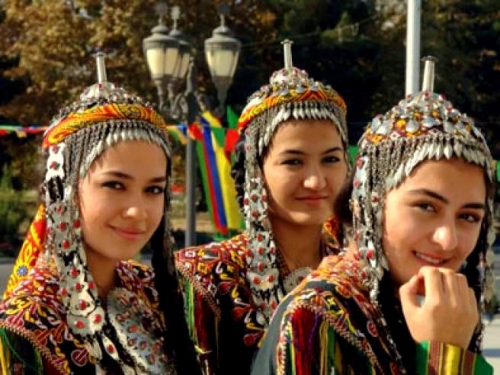
Le Turkménistan est le plus vulnérable en termes de sécurité conventionnelle, à savoir les conflits armés. Si les forces de sécurité intérieures du pays sont relativement efficaces pour empêcher le développement de sentiments dissidents et radicaux (d'après les sources ouvertes), la périphérie extérieure présente des zones vulnérables. A savoir, la frontière avec l'Afghanistan. Pendant la période de confrontation entre les talibans (interdits dans la Fédération de Russie) et les autorités officielles, les premiers ont utilisé la frontière avec le Turkménistan comme une sorte de camp d'entraînement, en bombardant les postes frontières. Incapable de résoudre le problème de quelque manière que ce soit, la partie turkmène a préféré payer les talibans en leur offrant des biens, du carburant et des lubrifiants en échange d'un cessez-le-feu. Il y a maintenant une accalmie à la frontière turkmène-afghane. Cependant, cette direction représente toujours le plus grand danger pour Ashgabat. Néanmoins, les dirigeants du pays restent attachés au principe de neutralité totale, sans conclure d'accords politico-militaires.
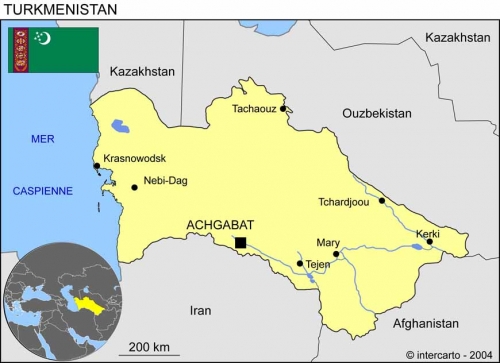
13:36 Publié dans Actualité | Lien permanent | Commentaires (0) | Tags : turkmenistan, asie, affaires asiatiques, asie centrale, eurasie, politique internationale |  |
|  del.icio.us |
del.icio.us |  |
|  Digg |
Digg | ![]() Facebook
Facebook
samedi, 28 mars 2015
Turkmenistan and the Geopolitical Tightrope between Russia/Iran and NATO/EU Powers
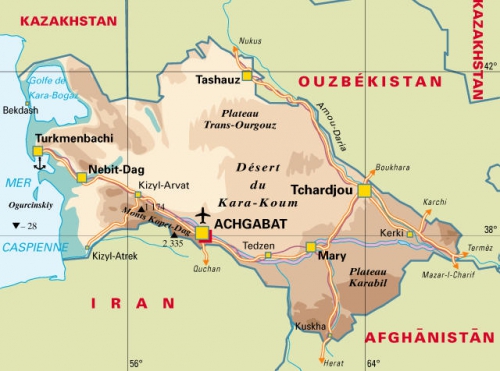
Turkmenistan and the Geopolitical Tightrope between Russia/Iran and NATO/EU Powers
Nuray Lydia Oglu, Hiroshi Saito and Lee Jay Walker
Ex: http://moderntokyotimes.com
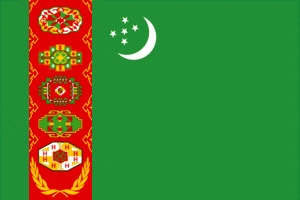 The nation of Turkmenistan is of major geopolitical significance because of its shared borders with Afghanistan, Iran, Kazakhstan and Uzbekistan. Of equal significance is the coastal area that links Turkmenistan to the Caspian Sea; thereby sharing a potent area with Azerbaijan, Iran, Kazakhstan and the Russian Federation. This reality means that current strains between the Russian Federation and NATO/European Union powers can be felt within important geopolitical decisions that Turkmenistan needs to make. However, the one biding factor prior to the recent clash between Moscow and Washington was the need to remain neutral when applicable.
The nation of Turkmenistan is of major geopolitical significance because of its shared borders with Afghanistan, Iran, Kazakhstan and Uzbekistan. Of equal significance is the coastal area that links Turkmenistan to the Caspian Sea; thereby sharing a potent area with Azerbaijan, Iran, Kazakhstan and the Russian Federation. This reality means that current strains between the Russian Federation and NATO/European Union powers can be felt within important geopolitical decisions that Turkmenistan needs to make. However, the one biding factor prior to the recent clash between Moscow and Washington was the need to remain neutral when applicable.
Energy politics, NATO encroachment, tensions between Iran and Turkey over Syria – and elements of distrust between Tehran and Washington – adds further complexity to an already complex issue. On top of this, Iran is worried by Turkey’s role in being a transit for Takfiri sectarian terrorists against Syria, with the knock on effect being further destabilization in Iraq.
Also, the crisis in Afghanistan remains up in the air. Therefore, Turkmenistan is worried about the growing menace of Takfiri forces, the possible menace of ISIS (IS – Islamic State), political Islam undermining indigenous Islam, and if Iraq is anything to go by – after America and allies pulled out – then the possible reality of new destabilization in Afghanistan. These important factors, and others, mean that Turkmenistan is increasingly feeling the global tensions that persist.
In the area of energy politics it is clear that the European Union (EU), Azerbaijan and Turkey have a different objective compared to Iran and the Russian Federation. This reality is clearly visible when viewing the Trans-Caspian Pipeline (TCP) because Moscow and Tehran oppose the TCP based on geopolitical and economic factors. Despite this, the EU, Azerbaijan and Turkey have made positive overtures that include areas outside of the TCP. Therefore, Turkmenistan needs to weigh up the TCP carefully given the geopolitical importance of energy politics alongside other important factors.
Zaur Shiriyev at The Jamestown Foundation states: “From Turkmenistan’s point of view, Gazprom’s declaration that it would cut its imports by nearly two-thirds—to 4 billion cubic meters (bcm)—has serious implications. The Russian financial crisis and decline in oil prices has had a direct impact on Turkmenistan’s internal market; notably, it has devalued its currency by 19 percent versus the dollar (Hurriyet Daily News, February 17). These various factors have strengthened Ashgabat’s motivations for seeking alternative markets for its gas. But Turkmenistan’s traditional approach to pipeline politics—that of “zero financial burden, hundred percent effectiveness”—remains unchanged, and so Ashgabat is interested in exporting to markets through existing pipelines or where there are opportunities for expansion, like with the China route. Despite Ashgabat’s dissatisfaction with Gazprom’s decision to cut gas imports, after twenty years of neutrality, Turkmenistan’s approach is unlikely to change; it will almost certainly maintain political sensitivity in its approach toward Moscow. This is particularly important given the broader atmosphere of confrontation between Russia and the West. Ashgabat is highly unlikely to actively support the European Union’s energy diversification strategy, as this would contradict the strongly business-based approach of the Turkmenistani leadership toward gas politics.”
The situation in Afghanistan and the rise of Takfiri Salafi forces in several nations is also worrying the political elites in Turkmenistan. Not only this, the murky role of NATO Turkey being an open conduit for several terrorist and sectarian forces against Syria also complicates the positive hand being plied by Ankara. Also, if NATO powers and allies can create a political vacuum in Afghanistan, Iraq and Libya and then leave, then how trustworthy are NATO powers in being a genuine partner in the fight against terrorism? Indeed, even political elites in Washington are questioning the current Erdogan government in Turkey therefore divisions within NATO clearly exist.
Turkmenistan refrained from joining the Collective Security Treaty Organization and clearly the Russian Federation must be disappointed by this reality. Of equal significance is the fact that Turkmenistan is only “a guest” of the Shanghai Cooperation Organization despite the powerful geopolitical significance of this organization. However, the decreasing role of America and NATO within Afghanistan may lead to Turkmenistan focusing more strongly on the Russian Federation, China and Iran.
It is abundantly clear that Turkmenistan prefers the geopolitical status quo but this may hinder the economic growth of this nation. Also, the growing menace of terrorism, Islamist indoctrination and the threat of greater destabilization in Afghanistan may lead to Turkmenistan to look towards the Russian Federation and Iran.
After all, it is abundantly clear that in Iraq it is Iranian military forces that are on the ground and helping the central government of this nation. This fact highlights the current weakness of the Obama administration in America. Therefore, while Turkmenistan doesn’t want to take sides, it is equally true that America is losing its influence in Afghanistan and Iraq respectively. However, for Turkmenistan, the economic equation is also of equal significance therefore the political tightrope will remain until brave decisions are taken by this nation.
Modern Tokyo News is part of the Modern Tokyo Times group
http://moderntokyotimes.com Modern Tokyo Times – International News and Japan News
http://sawandjay.com Modern Tokyo Times – Fashion
https://moderntokyonews.com Modern Tokyo News – Tokyo News and International News
http://global-security-news.com Global Security News – Geopolitics and Terrorism
00:05 Publié dans Actualité, Eurasisme, Géopolitique | Lien permanent | Commentaires (0) | Tags : actualité, géopolitique, eurasie, politique internationale, turkmenistan, asie centrale, géostratégie |  |
|  del.icio.us |
del.icio.us |  |
|  Digg |
Digg | ![]() Facebook
Facebook
mercredi, 07 mai 2014
City of London’s Imperialist Designs on Russia
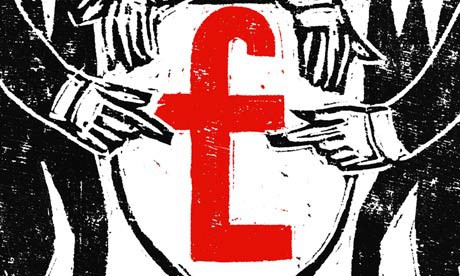
City of London’s Imperialist Designs on Russia
Yesterday the EU and US imposed additional sanctions on Russia, while 150 US troops landed in neighboring Estonia for military exercises. Two months after Ukraine’s democratically-elected President Viktor Yanukovych fled the country amidst the MI6/CIA/Mossad-orchestrated putsch in Kiev(http://deanhenderson.wordpress.com/2014/03/04/ukraine-falls-under-fascist-bankster-thumb/), the West continues to ramp up its aggression against Russia, despite repeated attempts at diplomacy by Russian President Vladimir Putin.
So what else is new?
The Rothschild-led City of London bankers have held grand imperialist designs on Russia’s rich natural resources for two centuries, always to be stymied by the odd nationalist czar or Stalinist. Putin thwarted their latest attempts when he jailed Israeli dual citizen Mikail Khodorkovsky and re-nationalized much of Russia’s energy sector. It is no coincidence that one Russian official sanctioned yesterday was Igor Sechin – president of Russian oil giant Rosneft, of which BP still owns a 20 % share.
(Excerpted from Chapter 17: Caspian Sea Oil Grab: Big Oil & Their Bankers…)
Unholy Alliance
While the international banking syndicates had always dealt with the Soviet Union, access to its vast oil resources remained limited until Ronald Reagan entered the White House in 1980, determined to splinter the Soviet Union into little pieces and open the country’s oilfields to the Four Horsemen. His point man in doing so was CIA Director Bill Casey, whose Roman Catholic Knights of Malta connections were thoroughly exploited.
The Vatican’s secretive Opus Dei “saintly Mafia” was behind the ascent of Polish Cardinal Karol Wojtyla to the Papacy. Wojtyla became Pope John Paul II and launched an Opus Dei/Vatican offensive to roll back Latin American liberation theology movements and East European communism. Fascism came naturally to Karol Wojtyla. During the 1940’s he was a chemical salesman for Nazi combine I. G. Farben. Wojtyla sold the Nazis the cyanide they used at their Auschwitz death camps. One of his best friends was Dr. Wolf Szmuness, mastermind of the 1978 Center for Disease Control Hepatitis B study in the US, through which the AIDS virus was introduced into the gay population. [722]
In 1982 Reagan met with Pope John Paul II. Prior to the meeting Reagan signed NSD-32, authorizing a wide range of economic, diplomatic and covert activities to “neutralize the USSR’s hold on Eastern Europe”. At the meeting the two agreed to launch a clandestine program to tear Eastern Europe away from the Soviets. Poland, the Pope’s country of origin, would be the key. Catholic priests, the AFL-CIO, the National Endowment for Democracy, the Vatican Bank and CIA would all be deployed.
The Vatican is the world’s largest owner of equities, using Swiss affiliate Banco di Roma per la Svizzera to conduct its more discretionary business. Italian fascist Benito Mussolini gave the Vatican generous tax exemptions which it still enjoys. Banco Ambrosiano’s P-2 leader Robert Calvi’s Grand Oriente Freemason’s supported reconciliation with the Vatican. Relations between the Vatican and the Freemasons were strained in the 11th century when the Greek Orthodox split from the Roman Catholics. Knights Templar and the Knights Hospitaler of St. John factions emerged. The latter was the Catholic faction. They changed their name to the Knights of Malta, after the island where they found refuge after their Crusades defeat, with help from the Vatican. Malta is a nexus of CIA/MI6/Mossad intrigues.
In the 13th century Pope Clement V, backed by France’s King Philip, charged the Protestant Knights Templars with heresy, citing their penchant for drug running, arms peddling, gambling and prostitution rings. These activities are what made the Templars “filthy rich”. Pope Clement made an example of Templar leader Jaques de Molay, whom he burned at the stake on Friday the 13th. [723] The Templars took their loot and fled to Scotland to found Scottish Rite Freemasonry. They bankrolled the House of Windsor, which controls Britain and presides at the apex of Freemasonry around the world. Masonic Lodge members enroll their children in the de Molay Society, which is named in honor of the toasted Templar pirate.
 Calvi’s attempt to reconcile protestant and Catholic secret societies was a success. He became paymaster to the Polish Solidarity movement, while Nixon Treasury Secretary David Kennedy’s dirty Continental Illinois Bank served as conduit for CIA funds sent by Bank of Cicero asset Bishop Paul Marcinkus to fund Solidarity. [724] The Vatican teamed up with Europe’s Black Nobility, the Bilderbergers and CIA to launch the top-secret JASON Society and armed South American dictators to quash liberation theology. In 1978 when Pope John Paul II took power, the Vatican issued a commemorative stamp featuring an Egyptian pyramid and the Roshaniya all-seeing eye. [725] The Vatican and the Illuminati Brotherhood were reunited.
Calvi’s attempt to reconcile protestant and Catholic secret societies was a success. He became paymaster to the Polish Solidarity movement, while Nixon Treasury Secretary David Kennedy’s dirty Continental Illinois Bank served as conduit for CIA funds sent by Bank of Cicero asset Bishop Paul Marcinkus to fund Solidarity. [724] The Vatican teamed up with Europe’s Black Nobility, the Bilderbergers and CIA to launch the top-secret JASON Society and armed South American dictators to quash liberation theology. In 1978 when Pope John Paul II took power, the Vatican issued a commemorative stamp featuring an Egyptian pyramid and the Roshaniya all-seeing eye. [725] The Vatican and the Illuminati Brotherhood were reunited.
Reagan’s meetings with Pope John Paul II were an affirmation of this powerful new alliance, which would now focus on bringing the Soviet Union to its knees. Even before Reagan met with the Pope the CIA had groomed an informant at the Polish Ministry of Defense- Colonel Ryszard Kuklinski. Kuklinski reported to the Vatican and helped organize the Polish Solidarity Movement, led by the wealthy Radziwill family who had funded JFK assassins via Permindex. Most Solidarity leaders were old-money aristocrats.
The precursor to Solidarity was the National Alliance of Solidarists, a Russian/Eastern European fascist hit squad funded by RD/Shell’s Sir Henry Deterding and German Vickers Arms Corporation President Sir Basil Zacharoff. Sir Auckland Geddes of Rio Tinto Zinc, which bankrolled Francisco Franco’s fascist coup in Spain, also contributed to the Solidarists. Geddes’ nephew- Ford Irvine Geddes- was chairman of the Inchcape’s Peninsular & Orient Navigation Company from 1971-1972. [726]
The Solidarist’s US headquarters was the Tolstoy Foundation, which is housed in the same building as Julius Klein Associates, which ran guns to the murderous Haganah and Stern Gang Zionist death squads who stole Palestinian lands to found Israel. Klein was an M16 Permindex insider who helped plan the JFK hit.
The Solidarists stepchild, the Solidarity Movement, was touted in the Western media as a great Polish liberating force. With boatloads of CIA help, Solidarity toppled the Communist government in Warsaw. Their straw man Lech Walesa became President of Poland. In 1995 Walesa was defeated by former Communist leader Aleksander Kwasniewski. Walesa was rewarded for his boot licking with a job at Pepsico.
CIA Director Casey demanded a constant focus on Eastern Europe at CIA. Casey met often with Philadelphia Roman Catholic Cardinal John Krol to discuss the Solidarity Movement. He utilized his Knights of Malta connections, leaning heavily on Brother Vernon Walters, whose spook resume read like a James Bond novel. Walter’s latest incarnation was Reagan Ambassador at Large to Vatican Secretary of State Agostino Cardinal Casaroli. [727] By 1991 Walters was US Ambassador to the UN, where he successfully beat the drums of war against Iraq. He was in Fiji that same year, just prior to the overthrow of that left-leaning government.
Other Knights of Malta members involved in the Eastern European destabilization effort were Reagan NSA and Robert Vesco lieutenant Richard Allen, Reagan NSA Judge William Clark, Reagan Ambassador to the Vatican William Wilson and Zbigniew Brzezinski. Other prominent Knights of Malta members include Prescott Bush, Nixon Treasury Secretary William Simon, Nixon coup-plotter Alexander Haig, contra supporter J. Peter Grace and Venezuelan Rockefeller lieutenant Gustavo Cisneros.
The Reagan team had a five-part strategy in its efforts to destroy the Soviet Union. First, it would pursue the JASON Society’s Star Wars concept in an attempt to engage the Soviets in a space-based arms race which they knew Moscow could not afford. Second, the CIA would launch covert operations in Poland, Czechoslovakia and Hungary in attempts to overthrow those Soviet-allied governments. While Walesa emerged in Poland, poet Vaclev Havel became CIA white knight in Czechoslovakia. Like Walesa, Havel became unpopular and was soon tossed out of his puppet presidency.
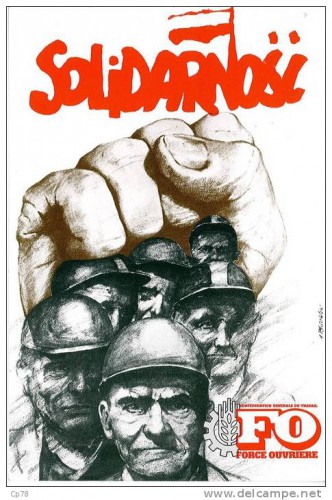 A component of the CIA destabilization program was to buy weapons from these East European nations to arm CIA-sponsored rebels in Nicaragua, Afghanistan, Angola and Mozambique, using BCCI and later BNL as conduits. The US also wanted to get their hands on the high-tech Soviet arsenal. Poland secretly sold the US an array of advanced Soviet weaponry worth $200 million. Romania did the same. Both countries saw their foreign debts reduced significantly. [728]
A component of the CIA destabilization program was to buy weapons from these East European nations to arm CIA-sponsored rebels in Nicaragua, Afghanistan, Angola and Mozambique, using BCCI and later BNL as conduits. The US also wanted to get their hands on the high-tech Soviet arsenal. Poland secretly sold the US an array of advanced Soviet weaponry worth $200 million. Romania did the same. Both countries saw their foreign debts reduced significantly. [728]
The third component of the Reagan strategy was to make financial aid to the Warsaw Pact contingent on economic privatization. Fourth, the US would blanket East European and Soviet airwaves with pro-Western propaganda, using fronts like Radio Liberty, Radio Free Europe and the Voice of America. The CIA financed local newspapers and magazines.
The Company got help inside the Soviet Union from its Mossad buddies in an effort spearheaded by media mogul and Mossad paymaster Robert Maxwell. When Maxwell threatened to reveal a meeting between KGB head Vladimir Kryuchkov and Mossad brass aboard his private yacht at which a coup against Mikhail Gorbachev was discussed, Mossad ordered a hit on Maxwell. On November 4, 1991 as he sailed around the Canary Islands Maxwell was assassinated by Israeli commandos. The mass exodus of Russian Jews to Israeli-occupied settlements in Palestine was part of the secret deal between Mossad and Kryuchkov, who is still serving time in a Moscow prison for his treasonous role in the Gorbachev coup. [729]
But it was the fifth and final component of Reagan’s strategy that had the Four Horsemen salivating. Reagan’s spooks initiated an economic warfare campaign against the Soviet Union, which included a freeze on technology transfers, counterfeiting of the Russian ruble and the sponsoring of separatist Islamist groups in the Soviet Central Asian Caucasus. The jihadis who were instructed to target a key transcontinental natural gas pipeline which the Soviets were building. The Soviets had more natural gas than any country on earth and saw the completion of this pipeline as their cash cow for the 21st century. [730] Big Oil wanted to milk that cow.
It’s the Oil, Stupid
When the Soviet Union’s last President Mikhail Gorbachev announced his perestroika and glasnost campaigns to privatize his country’s economy, he was aiding the Illuminati in destroying his country. Was Gorbachev duped, an unwitting accomplice, a CIA deep-cover agent or a mind-controlled Operation Presidio Temple of Set victim? Whatever the case, he played a key role in dismantling the Soviet Union.
The Soviets controlled not only the vast resources of their own nation, but Third World resources in Soviet-allied Comecon nations. Part of perestroika was to cease Soviet aid to these developing nations to ease the growing Soviet debt burden which, like the US debt, accrued largely from decades of Cold War military spending. The two superpowers’ debt was held by the same international banks, which now used this debt lever to pick a winner and to open Russian and Third World resource pools to their corporate tentacles. [731]
When the Berlin Wall fell and Gorbachev was overthrown in favor of IMF crony Boris Yeltsin, the Four Horsemen rushed to Moscow to begin making oil deals. Oil and natural gas had always been the Soviet’s main export and it remained so for the new Russia. In 1991, the country earned $13 billion in hard currency from oil exports. In 1992 Yeltsin announced that Russia’s world leading 9.2 billion barrel/day oil sector would be privatized.
Sixty percent of Russia’s Siberian reserves had never been tapped. [732] In 1993 the World Bank announced a $610 billion loan to modernize Russia’s oil industry- by far the largest loan in the bank’s history. World Bank subsidiary International Finance Corporation bought stock in several Russian oil companies and made an additional loan to the Bronfman’s Conoco for its purchase of Siberian Polar Lights Company. [733]
The main vehicle for international banker control over Russian oil was Lukoil, initially 20%-owned by BP Amoco and Credit Suisse First Boston, where Clinton Yugoslav envoy and Dayton Peace Accords architect Richard Holbrooke worked. Bush Sr. Attorney General Dick Thornburgh, who orchestrated the BNL cover-up, was now CS First Boston’s Chief Financial Officer. A handful of Zionist Russian oligarchs, collectively known as the Russian Mafia, owned the rest of Lukoil, which served as the Saudi ARAMCO of Russia for the Four Horsemen, a partner to Big Oil in projects throughout the country which involved truly staggering amounts of capital.
These included Sakhalin Islands projects known as Sakhalin I, a $15 billion Exxon Mobil venture; and Sakhalin II, a $10 billion deal led by Royal Dutch/Shell which included Mitsubishi, Mitsui and Marathon Oil as partners. Siberian developments were even larger. RD/Shell is a 24.5% partner in Uganskneftegasin, which controls a huge Siberian natural gas field. At Priobskoye, BP Amoco operates a $53 billion project. At Timan Pechora on the Arctic Ocean a consortium made up of Exxon Mobil, Chevron Texaco, BP Amoco and Norsk Hydo runs a $48 billion venture.
 In November 2001 Exxon Mobil announced plans to invest another $12 billion in an oil and gas project in the Russian Far East. RD/Shell announced a $8.5 billion investment in its Sakhalin Islands concessions. BP Amoco made similar proclamations. [734] In 1994 Lukoil pumped 416 million barrels of oil, making it fourth largest producer in the world after RD/Shell, Exxon Mobil and part-owner BP Amoco. Its fifteen billion barrels in crude reserves rank second in the world to Royal Dutch/ Shell. [735]
In November 2001 Exxon Mobil announced plans to invest another $12 billion in an oil and gas project in the Russian Far East. RD/Shell announced a $8.5 billion investment in its Sakhalin Islands concessions. BP Amoco made similar proclamations. [734] In 1994 Lukoil pumped 416 million barrels of oil, making it fourth largest producer in the world after RD/Shell, Exxon Mobil and part-owner BP Amoco. Its fifteen billion barrels in crude reserves rank second in the world to Royal Dutch/ Shell. [735]
The Soviet Caucasus, with encouragement from Langley, soon split from Russia. The map of Central Asia was re-written as Kazakhstan, Uzbekistan, Tajikistan, Turkmenistan, Kyrgyzstan, Armenia, Azerbaijan, Ukraine and Georgia all declared their independence. The pipeline Reagan ordered targeted carried Soviet natural gas east to the North Pacific port of Vladivostok and west to the Black Sea port of Novorrossiysk from the world’s richest known natural gas fields lying beneath and abutting the shoreline of the Caspian Sea, which lies in the heart of Caucasus.
The Four Horsemen coveted this resource more than any in the world. They wanted to build their own private pipelines once they got their hands on the Caspian Sea natural gas fields, which also contain an estimated 200 billion barrels of crude oil. Oil industry privatizations were quickly announced in the new Central Asian Republics which had, by virtue of their independence, taken control of the vast Caspian Sea oil and gas reserves. By 1991 Chevron was holding talks with Kazakhstan. [736]
The Central Asian Republics became the largest recipients of USAID aid, as well as ExIm Bank, OPIC and CCC loans. Azerbaijan, Turkmenistan and Kazakhstan were especially favored. These countries control the shoreline of the Caspian Sea, along with Russia and Iran. In 1994 Kazakhstan received $311 million in US aid and another $85 million to help dismantle Soviet-era nuclear weapons. President Clinton met with Kazakhstan President Nursultan Nazarbayev. They signed an array of agreements ranging from disarmament deals to space research cooperation. Kazakhstan, with an estimated 17.6 billion barrels of oil reserves, had been a strategic part of the Soviet nuclear weapons grid and was home to the Soviet space program.
The two leaders also signed an agreement providing investment protection for US multinationals. The Free Trade Institute and US Chamber of Commerce sent officials to train Kazakhs in the finer arts of global capitalism. The Four Horsemen moved in swiftly. Chevron Texaco laid claim to the biggest prize- the $20 billion Tenghiz oilfield- then grabbed another gusher at Korolev. Exxon Mobil signed a deal to develop an offshore concession in the Caspian. [737] Tengizchevroil is 45%-owned by Chevron Texaco and 25%-owned by Exxon Mobil. [738] President George W. Bush’s NSA and later Secretary of State Condaleeza Rice, an expert on Central Asia, sat on the board at Chevron alongside George Schultz from 1989-1992. She even had an oil tanker named after her.
Across the Caspian Sea, Azerbaijan was receiving hundreds of millions of dollars in US aid. BP Amoco led a consortium of seven oil giants who spent an initial $8 billion to develop three concessions off the coast of the capital Baku- historic base camp of Big Oil in the region. [739] BP Amoco and Pennzoil- recently acquired by Royal Dutch/Shell- took control of the Azerbaijan Oil Company, whose board of directors included former Bush Sr. Secretary of State James Baker.
In 1991 Air America super spook Richard Secord showed up in Baku under the cover of MEGA Oil. [740] Secord & Company did military training, sold Israeli arms, passed “brown bags filled with cash” and shipped in over 2,000 Islamist fighters from Afghanistan with help from Gulbuddin Hekmatyar. Afghan heroin began flooding into Baku. Russian economist Alexandre Datskevitch said of 184 heroin labs that police discovered in Moscow in 1991, “Every one of them was run by Azeris, who use the proceeds to buy arms for Azerbaijan’s war against Armenia in Nagorno-Karabakh”. [741]
A Turkish intelligence source claims that Exxon and Mobil were behind the 1993 coup against elected Armenian President Abulfaz Elchibey. Secord’s Islamists helped. Osama bin Laden set up an NGO in Baku as a base for attacking the Russians in Chechnya and Dagestan. A more pliant President Heidar Aliyev was installed. In 1996, at the behest of Amoco’s president, he was invited to the White House to meet President Clinton- whose NSA Sandy Berger held $90,000 worth of Amoco stock. [742]
Armenian separatists backed by the CIA took over the strategic Armenian regions of Nagorno-Karabakh and Nakhnichevan which border Turkey and Iran. When Turkish President Turgut Ozal mentioned intervention in Nakhnichevan to back the Azerbaijani seizure, Turkish Premier Suleyman Demirel quickly played down the statement from the key US ally. These two regions are critical to Big Oil plans to build a pipeline from the Caspian Sea across Turkey to the Russian Black Sea port of Novorrossiysk. The same route is utilized by Turkey’s Gray Wolves mafia in their Central Asia to Europe heroin endeavors. When Gray Wolf Mehmet Ali Agca tried to assassinate Pope John Paul II in 1981, the CIA used its Gladio strategy, trying to pin it on Bulgaria’s Communist Lukashenko government.
Lukoil owns 26% of the Russian Black Sea port at Novorrossiysk. Its president Vayit Alekperov wanted to build the Caspian pipeline through Grozny in Chechnya, while the Four Horsemen preferred the route through Turkey. CIA support for Armenian separatists and Chechen Islamist rebels ensured chaos in Grozny. Alekperov finally agreed to the Turkish route.
In 2003 the Defense Department proposed a $3.8 million military training grant for Azerbaijan. Later they admitted it was to protect US access to oil. As author Michael Klare put it, “Slowly but surely, the US military is being converted into a global oil-protection service”. [743]
Turkmenistan, which borders the Caspian Sea on the southeast, is a virtual gas republic, containing massive deposits of natural gas. It also has vast reserves of oil, copper, coal, tungsten, zinc, uranium and gold. The biggest gas field is at Dauletabad in the southeast of the country, near the Afghan border. The Unocal-led Centgas set about building a pipeline which would connect the oil fields around Chardzhan to the Siberian oilfields further north. More crucial to Centgas was a gas pipeline from Dauletabad across Afghanistan and Pakistan to the Indian Ocean. [744] Advisers to the project included Henry Kissinger. Unocal is now part of Chevron.
With the Four Horsemen firmly in charge of Caspian Sea reserves, the Caspian Pipeline Consortium was born. Chevron Texaco took a 15% stake with the other three Horsemen and Lukoil splitting the rest. Pipeline security was provided by the Israeli firm Magal Security Systems, which is connected to Mossad. Azerbaijan and Turkmenistan have especially cozy relations with Israel via Special Ambassador Yusef Maiman, who is president of the Israeli Mehrav Group. Mehrav is involved in a project in Turkey to divert water from the upper Tigres and Euphrates Rivers to the southeast part of Turkey and away from Iraq. [745] The Caspian pipeline was built by Bechtel in partnership with GE and Wilbros Group. The pipeline quietly began moving oil and gas in November 2001, just two months after 911.
Bechtel also built the oilfield infrastructure at Tengiz for Chevron Texaco. In 1995 Bechtel led a USAID-funded consortium to restructure the energy sectors of eleven Central and Eastern European nations in line with IMF mandates. Bechtel received a massive contract to upgrade Russia’s many ailing aluminum smelters in tandem with Pechiney. Lukoil contracted with New Jersey-based ABB Lummus Crest (formed when engineering giants Asea Braun Boveri and Lummis Crest merged) to build a $1.3 billion refinery at the Novorrossysk port and to do a $700 million upgrade on its refinery at Perm.
The Bush Jr. Administration now planned a series of additional Caspian Sea pipelines to compliment the Tenghiz-Black Sea route. A Baku-Tblisi-Ceyhan pipeline was built by a Four Horsemen consortium led by BP Amoco. The law firm representing the BP-led consortium is James Baker’s family law firm- Baker Botts. The BP Amoco pipeline runs the length of the country of Georgia through its capital Tblisi.
In February 2002 the US announced plans to send 200 military advisers and attack helicopters to Georgia to “root our terrorism”. [746] The deployment was a smokescreen for pipeline protection. In September 2002 Russian Foreign Minister Igor Ivaniov accused Georgia of harboring Chechen rebels. In October 2003 Georgian President Eduard Schevardnadze was forced to step down in a bloodless revolution. According to a December 11, 2003 article on the World Socialist Party website, CIA sponsored the coup.
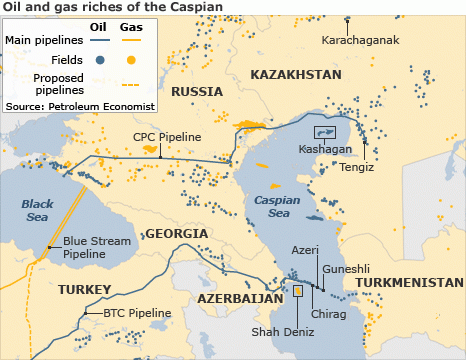
In September 2004 hundreds of Russian school children were killed when Chechen separatists seized their school building. Russian President Vladimir Putin said of the incident, “Certain political circles in the West want to weaken Russia, just like the Romans wanted to weaken Carthage.” He accused “foreign intelligence services” of complicity in the attacks. His adviser Aslanbek Aslakhanov went further, stating on Russian Channel 2 News, “The men had their conversations not within Russia, but with other countries. They were led on a leash. Our self-styled friends have been working for several decades to dismember Russia… (they are the) puppeteers and are financing terror.” Russia’s KM News ran the headline, “School Seizure was Planned in Washington and London”. [747]
Lukoil epitomizes the corruption so rampant in Russia since the Soviet collapse. Bribery is the norm. Lukoil has given luxury jets to the mayor of Moscow, the head of Gazprom (the state-owned natural gas monopoly) and Kazakhstan President Nazarbayev. In the mid-1990’s Lukoil announced that it would sell another 15 % stake to foreign stockholders through its largest owner and financial adviser CS First Boston and the Bank of New York. [748] In 2002 they announced plans to sell off another big stake.
According to Kurt Wulff of the oil investment firm McDep Associates, the Four Horsemen, romping in their new Far East pastures, saw asset increases from 1988-1994 as follows: Exxon Mobil- 54%, Chevron Texaco- 74%, Royal Dutch/Shell- 52% and BP Amoco- 54%. The Horsemen had more than doubled their collective assets in six short years. This quantum leap in Anglo-American global power had everything to do with the takeover of the old Soviet oil patch and the subsequent impoverishment of its birthright owners.
[722] Behold a Pale Horse. William Cooper. Light Technology Publishing. Sedona, AZ. 1991.
[723] The Robot’s Rebellion: The Story of the Spiritual Renaissance. David Icke. Gateway Books. Bath, UK. 1994. p.94
[724] Hot Money and the Politics of Debt. R.T. Naylor. The Linden Press/Simon & Schuster. New York. 1987. p.78
[725] Ibid. p.165
[726] Dope Inc.: The Book that Drove Kissinger Crazy. The Editors of Executive Intelligence Review. Washington, DC. 1992
[727] “The Unholy Alliance”. Carl Bernstein. Time. 2-24-92. p.28
[728] “US Obtained Soviet Arsenal from Poland”. Eugene Register-Guard. 2-13-94
[729] The Other Side Of Deception. Victor Ostravsky. HarperCollins Publishers. New York. 1994.
[730] Bernstein. p.28
[731] “The Dismantling of the Soviet Union”. Peter Symon. Philippine Currents. November/December 1991.
[732] “Drilling for a Miracle”. Fred Coleman. US News & World Report. 12-7-92. p.54
[733] Evening Edition. National Public Radio. 6-18-93
[734] “Exxon’s Russian Oil Deal Makes Other Firms Feel Lucky”. Wall Street Journal. 12-13-01
[735] “The Seven Sisters Have a Baby Brother”. Paul Klebnikov. Forbes. 1-22-96. p.70
[736] Taliban: Militant Islam, Oil and Fundamentalism in Central Asia. Ahmed Rashid. Yale University Publishing. New Haven, CT. 2001. p.145
[737] “Christopher Promises Aid to Oil-Rich Kazakhstan”. AP. Northwest Arkansas Morning News. 10-24-93
[738] 10K Filings to SEC. Exxon Mobil and Chevron Corporations. 3-28-01
[739] “The Quietly Determined American”. Paul Klebnikov. Forbes. 10-24-94. p.48
[740] Azerbaijan Diary: A Rogue Reporter’s Adventures in a Oil-Rich, War-Torn, Post- Soviet Republic. Thomas Goltz. M.E. Sharpe. Armonk, NY. 1999. p.272
[741] “al-Qaeda, US Oil Companies and Central Asia”. Peter Dale Scott. Nexus. May-June, 2006. p.11-15
[742] See No Evil: The True Story of a Ground Soldier in the CIA’s War on Terrorism. Robert Baer. Crown. New York. 2002. p.243-244
[743] Blood and Oil: The Dangers and Consequences of America’s Growing Dependency on Imported Petroleum. Michael T. Klare. Metropolitan/Henry Holt. 2004. p.6-7
[744] Escobar. Part I
[745] “The Roving Eye: Pipelineistan, Part II: The Games Nations Play”. Pepe Escobar. Asia Times Online. 1-26-02
[746] “Wolf Blitzer Reports”. CNN. 2-27-02
[747] “Paranotes: Russian School Seige Conspiracy”. Al Hidell. Paranoia. Issue 37. Winter 2005.
[748] Klebnikov. 1-22-96. p.72
Dean Henderson is the author of five books: Big Oil & Their Bankers in the Persian Gulf: Four Horsemen, Eight Families & Their Global Intelligence, Narcotics & Terror Network, The Grateful Unrich: Revolution in 50 Countries, Das Kartell der Federal Reserve, Stickin’ it to the Matrix & The Federal Reserve Cartel. You can subscribe free to his weekly Left Hook column @ www.deanhenderson.wordpress.com
00:05 Publié dans Actualité, Affaires européennes | Lien permanent | Commentaires (0) | Tags : russie, caucase, azerbaïdjan, arménie, turkménistan, zone caspienne, europe, asie, affaires européennes, affaires asiatiques, politique internationale, géopolitique, hydrocarbures, gaz, gaz naturel, gazoducs, pétrole, city of london, bourse, économie |  |
|  del.icio.us |
del.icio.us |  |
|  Digg |
Digg | ![]() Facebook
Facebook
jeudi, 14 janvier 2010
Teheran, epicentro di un terremoto geostrategico
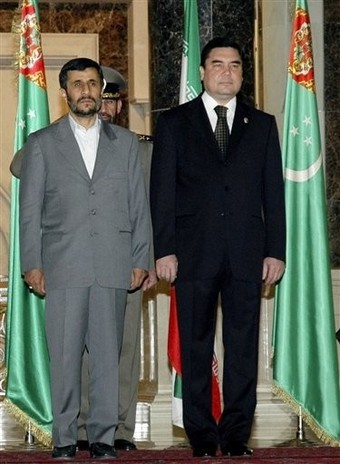 Teheran, epicentro di un terremoto geostrategico
Teheran, epicentro di un terremoto geostrategico
Ahmadinejad e Berdymukhamedov inaugurano un gasdotto in Turkmenistan
Pietro Fiocchi
Dopo aver riscosso un certo successo in Tajikistan, dove il presidente Rakhmon ha garantito sostegno al programma nucleare civile di Teheran, Ahmadinejad era ieri in Turkmenistan. Nella capitale Ashgabat ha incontrato il leader dell’ex repubblica sovietica Gurbanguly Berdymukhamedov, con il quale si è congratulato per la sua politica imparziale, approccio saggio per assicurare pace e stabilità nella regione.
A detta dello stesso Ahmedinejad, tra i governi dei due Paesi centroasiatici ci sarebbe una perfetta sintonia su una serie di questioni di carattere locale e internazionale. Posizioni vicine sulla questione Afghanistan. Il presidente iraniano è tornato a scandire concetti ormai noti: “l’Iran incoraggia soluzioni ai problemi della regione che siano giusti per tutti i Paesi e per tutti i popoli”.
Berdymukhamedov, forse per restare fedele alla sua fama di saggia neutralità, non ha fatto eco al suo ospite. In ogni caso, in precedenza aveva fatto sapere di non essere favorevole a interventi militari sul fronte afghano. Posizioni molto vicine a quelle di Mosca e di tutti gli altri cinque membri dell’Organizzazione di Shangai per la cooperazione, in cui Teheran è osservatore e aspirante membro. Ashgabat con questa organizzazione non ha niente a che fare, ma di recente ha riscoperto con il Cremlino l’antica amicizia e concluso vari accordi nel settore energetico.
Non è verosimile che il Turkmenistan si abbandoni a colpi di testa e si privi della simpatia di due alleati strategici come la Russia e l’Iran, così ben disposti. Quindi l’Eurasia, quella che conta, è compatta nel proporre compromessi che escludano l’uso della forza, tanto per Kabul quanto per l’intera Asia Centrale. Difficile che sia altrimenti: tra vicini di casa sono preferibili le buone maniere.
Discorsi sulla sicurezza a parte, il punto forte dei tre giorni di Ahmadinejad in Turkmenistan è l’inaugurazione, oggi, di un nuovo gasdotto. Lungo 30,5 chilometri, il gasdotto permetterà di aumentare le forniture destinate a Teheran fino 14 miliardi di metri cubi di gas all’anno, per raggiungere in seguito i 20 miliardi. Non sarà un problema: Ashgabat ne produce 80 miliardi l’anno, di cui 30 vanno in Russia e 6 in Cina. A quanto pare in tema di idrocarburi l’Iran per un po’ potrà stare tranquillo. C’è inoltre la banca del Qatar, che finanzierà prossimamente, con la cifra iniziale di 400 milioni di euro, lo sviluppo del giacimento petrolifero di Esfandiar, nel Golfo.
Sempre in tema di affari e prospettive c’è una novità: con l’anno nuovo è in vigore l’Unione doganale di Russia, Bielorussia e Kazakistan. Un gigante economico, una nuova realtà politica, di cui l’alleato Iran saprà amichevolmente approfittare.
06 Gennaio 2010 12:00:00 - http://www.rinascita.eu/index.php?action=news&id=261
00:25 Publié dans Géopolitique | Lien permanent | Commentaires (0) | Tags : géopolitique, politique internationale, iran, turkménistan, asie centrale, affaires asiatiques, asie, moyen orient, diplomatie, gazoducs, oléoducs, hydrocarbures, énergie |  |
|  del.icio.us |
del.icio.us |  |
|  Digg |
Digg | ![]() Facebook
Facebook



